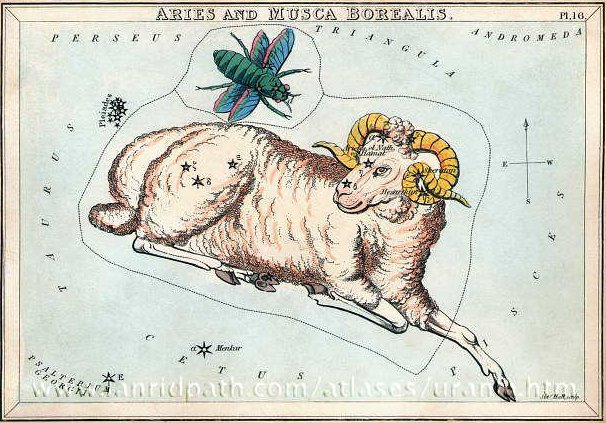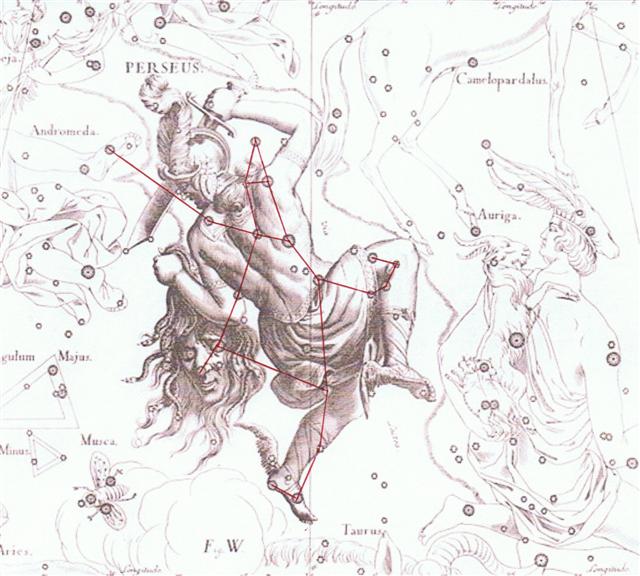Side b is beginning with
the heliacal rising of
Polaris in April 17, a
date when also Mesarthim
(γ
Arietis) and Sheratan (β
Arietis) rose with the
Sun. This pair of stars
ruled the first Hindu
lunar mansion Ashvini:
|
1. Ashvini |
|
|
|
Almuqaddam
12 |
13 (337) |
Al Muakhar 1 |
|
April 17
(107) |
18 |
19 |
 |
 |
 |
|
Cb1-1 (393) |
Cb1-2 |
Cb1-3 |
|
E tupu - ki roto |
o te
hau tea |
|
Polaris,
Baten Kaitos (26.6), Metallah (26.9), Segin,
Mesarthim,
ψ Phoenicis (27.2),
Sheratan,
φ Phoenicis (27.4) |
no star
listed |
Alrisha, χ
Phoenicis (29.2) |
|
October 18 |
19 |
20 (293) |
|
Assarfa 11 |
12 (156) |
13 |
|
φ Centauri (211.0), υ¹
Centauri (211.1) |
υ² Centauri (211.8), τ
Virginis (211.9), Agena (212.1) |
14h (213.1) |
|
Thuban
(212.8), χ Centauri (213.0), Menkent (213.1) |
|
1 |
Ashvini |
β and γ
Arietis |
Horse's
head |

Sheratan is slightly above Mesarthim on the curved frontal horn of
the Ewe and in this picture time runs from right to left, i.e.
with Mesarthim as the first Greek lettered 'point' in Aries.
Probably side b is beginning with the beginning
of the year.
The
brightest star in Aries is Hamal (α)
on her head and in rongorongo times Hamal rose very close to
right ascension 2h:
|
Al Muakhar 2
(339) |
|
April 20
(110) |
 |
|
Cb1-4 (396) |
| ki te henua -
te maro |
|
2h
(30.4) |
|
Alamak
(29.7),
Hamal
(30.5) |
|
October 21 (294) |
|
Auva 1
(158) |
| no
star listed |

Next in the text are 7 glyphs beginning with
April 21, where we can count 16 * 21 = 336, given that April
is not month number 4 but month number16:
|
Al Muakhar
3 (340) |
4 |
5 |
|
April 21
(111) |
22 |
23 |
 |
 |
 |
|
Cb1-5 |
Cb1-6 |
Cb1-7 (399) |
| no stars listed |
|
October 22 (295) |
23 |
24 |
|
Auva 2 |
3 (160) |
4 |
|
Asellus Tertius, κ
Virginis, 14
Bootis (214.8), 15
Bootis (215.2), Arcturus (215.4), Asellus Secundus
(215.5) |
Syrma, λ Bootis (215.6),
ι Lupi, 18 Bootis
(216.3), Khambalia (216.4), υ Virginis (216.5) |
ψ Centauri (216.6) |
| |
|
Al Muakhar 6 |
7 |
8 (345) |
9 |
| April 24 |
25 |
26 (116) |
27 |
 |
 |
 |
 |
| Cb1-8 |
Cb1-9 |
Cb1-10 |
Cb1-11 (403) |
| Mira (33.7) |
no stars listed |
|
October 25 |
26 |
27 (300) |
28 |
|
Auva 5 |
6 |
7 (164) |
8 |
|
Asellus Primus (217.8),
τ Lupi (218.1) |
φ Virginis (218.7), σ Lupi (219.1), ρ Bootis (219.5) |
Haris (219.7). σ Bootis (220.2), η Centauri (220.4) |
ρ Lupi (221.0), Toliman (221.2) |
|
rutua - te
pahu - rutua te maeva - atua rerorero - atua
hiko ura - hiko o tea - ka higa te ao ko te henua ra
ma te hoi atua |
336 is the manzil day number for
Almuqaddam 12 (corresponding to April 17). In other
words, there are 5 days from the heliacal rising of
Polaris, Mesarthim, and Sheratan, to the very complicated
glyph Cb1-6 where a kind of separation is illustrated.
April 21 is like March 21 (the northern
spring equinox) and June 21 (the northern midsummer) a
date connected with radical changes.
Probably Metoro's words are here
describing the whole package of glyphs instead of
commenting on them each separately. He is beginning by
stating that drums (te pahu) are sounding (rutua)
as a means of welcoming (te maeva) and this is
meaningful if the beginning of the text on side b is
related to the onset of a new year.
The 2nd Hindu lunar mansion is Bharani,
ruled by 3 stars in the asterism Musca Borealis.
|
2 |
Bharani |
35, 39,
and 41 Arietis |
Yoni,
the female organ of reproduction |
|
Al Muakhar 10 |
11 (348) |
12 |
| April 28 |
29 |
30 (120) |
 |
 |
 |
| Cb1-12 |
Cb1-13 (405) |
Cb1-14 |
| manu rere - kua rere ga manu - ki te ragi |
eaha te nuku erua |
koia kua huki |
| no stars listed |
Head of the Fly (39.6), Kaffaljidhma (39.8), Angetenar (40.2) |
|
October 29 |
30 |
31 (304) |
|
Auva 9 |
10 |
11 (168) |
| π Bootis (221.8), ζ Bootis (221.9), 31 Bootis (222.0), Yang Mun (222.1), Rijl al Awwa (222.5) |
ο Bootis (222.9), Izar (223.0), 109 Virginis (223.3) |
Zuben Elgenubi (224.2), ξ Bootis, ο Lupi (224.5) |
|
2. Bharani |
|
|
| Al Muakhar 13 (350) |
Alrescha 1 |
2 |
| May 1 (121) |
2 |
3 |
 |
 |
 |
| Cb1-15 |
Cb1-16 |
Cb1-17 (409) |
| e niu tu |
ki te ariki - e ka hua ra tona rima |
koia kua iri i ruga o te rima - e o to vaha mea |
| Right Wing (40.9), Bharani (41.4) |
τ² Eridani (41.7) |
no star listed |
|
November
1 (305) |
2 |
3 |
|
Auva 12 |
13 (170) |
Simak 1 |
| Kochab (225.0) |
Ke Kwan (226.3), Ke Kwan (226.4) |
Zuben Elakribi (226.8), ω Bootis (227.2), Nekkar (227.3) |
There are 14 days from April 17 (107) to
May 1 (121) and also the 1st Arabic manzil station
(Sheratan) has 14 days (instead of the normal 13 days).
The central glyph in the following
triplet refers to May 5 and manzil day 354 (= 12 * 29½).
| Alrescha 3 |
4 (354) |
5 |
| May 4 |
5 (125) |
6 |
 |
 |
 |
| Cb1-18 |
Cb1-19 |
Cb1-20 |
| manu moe ra |
ki to mata |
e nuku mata |
| Acamar (43.6) |
Menkar (44.7) |
3h (45.7) |
| Algol (45.9), Misam (46.2) |
|
November 4 |
5 |
6 (310) |
| Simak 2 (172) |
3 |
4 |
| Nadlat (227.8), π Lupi (227.9), Zuben Hakrabim (228.3) |
λ Lupi (228.9) |
κ Lupi (229.7), ζ Lupi (229.8), χ Bootis (230.2) |
Once, a long time ago, Algol, the devil's star, probably represented the northern winter and in rongorongo times it had moved ahead in the year to 3h. Perseus severed the head of the Medusa demon (who's eyes turned men into stone) with Algol as her left eye:

The last quartet of glyphs in the
line maybe should be read together with the glyphs
in the following line:
| Alrescha 6 |
7 |
8 |
9 (359) |
| May 7 |
8 |
9 |
10 (130) |
 |
 |
 |
 |
| Cb1-21 (413) |
Cb1-22 |
Cb1-23 |
Cb1-24 |
| hoea |
ko te rima |
kua oo ki te vai |
ma te ua |
| Botein (46.9) |
Zibal (48.0) |
no star listed |
Algenib Persei (50.0), ο Tauri (50.2) |
|
November 7 |
8 |
9 |
10 (314) |
| Simak 5 |
6 |
7 (177) |
8 |
| Princeps (230.6), Zuben Elschemali (230.8), μ Lupi (231.3) |
ο Cor. Borealis (232.0), δ Lupi (232.1), φ¹, ν² Lupi (232.2), ν¹ Lupi (232.3), ε Lupi (232.4), φ² Lupi (232.5) |
Pherkad (232.6), η Cor. Borealis (232.8), υ Lupi (232.9), Alkalurops (233.1) |
Nusakan (234.0) |
In rongorongo times the important star Algenib (α) at the illuminated right side of Perseus was located precisely 50 days after the March equinox. At the
other end of the year the Gregorian calendar had
day = 130 + 184 = 314 (November 10).
|

















